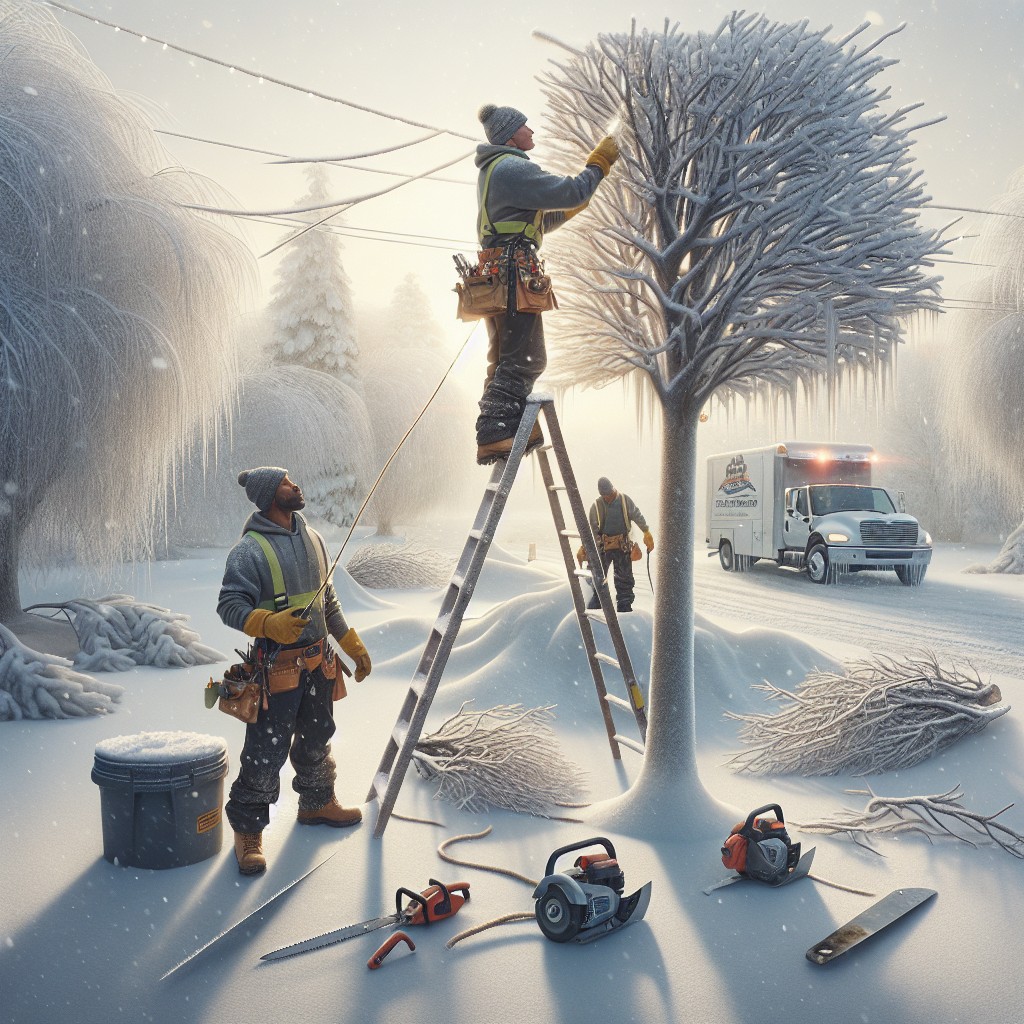Last updated on
Economizing on tree work becomes a reality because this guide compares affordable and efficient service providers that prioritize your needs and budget.
Key takeaways:
- Timing tree work in late fall and winter can save money.
- Compare quotes and services from different tree companies.
- Negotiate terms and discuss package deals with local arborists.
- Take advantage of seasonal discounts and special offers.
- Ensure proper insurance, accreditation, and qualifications of tree service providers.
Cheapest Time of Year for Tree Work

Timing your tree work can significantly affect your wallet. Generally, the dormant season, which falls in late fall and winter, is when you can usually snag the best deals. Trees are often leafless and easier for arborists to handle, leading to quicker jobs and lower costs. Moreover, the demand for tree services slows down during these cooler months, which can translate into lower prices as companies compete for business.
Not every tree service follows this pattern, so it’s wise to ask for off-season discounts. Some professionals might also be looking to fill their schedules during down times and could be open to negotiation. Remember, though, that exact timing will vary based on your climate zone and the specific tree species you’re dealing with. Always consult a professional to ensure the timing of the work does not harm the tree.
Comparing Quotes From Different Tree Services

When assessing quotes from various tree services, adopt a critical yet informed approach. A lower quote might omit services that a higher quote includes, so ensure that each quote details exactly what is covered. This means checking that tasks such as stump grinding, debris removal, and hauling are explicitly stated.
Look beyond the numbers; consider the company’s reputation, reviews, and response time to inquiries, as these elements can also indicate the quality and reliability of the service provided. Not all services are created equal; for example, a company specializing in large tree removal might charge more but have the necessary equipment and insurance to handle bigger jobs safely.
It’s essential to remember that while cost is crucial, it’s not the only factor to weigh. A slightly higher investment could mean a significant difference in the outcome of the job. Thus, compare similar services among providers to ensure you’re making an apple-to-apples comparison. Don’t hesitate to ask for itemized quotes to understand each cost component, which can also uncover potential hidden fees. Be aware that in the tree service industry, extremely low quotes may be a red flag for subpar service or uninsured operations.
Negotiating With Local Arborists
Achieving the best price for tree work often hinges on your ability to discuss terms effectively with a local arborist. Before entering negotiations, arm yourself with research; knowledge of average costs and services provided by competitors creates leverage.
When expressing your budget constraints, be upfront yet courteous, allowing arborists to tailor their services to your financial capacity. Inquire about package deals or whether performing some tasks, like clearing debris post-service, could lower the overall cost.
Remember, it’s also crucial to ascertain that a reduced price doesn’t mean a compromise on insurance or quality of work. Demonstrating flexibility in scheduling could result in better rates, as arborists may offer discounts for work during their slower periods.
Engaging in an open dialogue fosters a relationship that not only secures a fair price but also ensures the health and safety of your trees and property.
Seasonal Discounts and Special Offers
Outdoor services like tree work often come with built-in seasonal variability, which savvy homeowners can leverage to their advantage. During colder months, when trees are dormant and demand for tree services dips, companies are more likely to offer competitive rates to keep their crews busy.
Here are some quick tips to secure those deals:
- Keep an eye out for winter specials: Arborists may lower prices from late fall to early spring, aiming to fill their slower season schedules.
- Ask about off-season discounts: When you call for a quote, inquire if there are any current promotions or upcoming deals.
- Check for bulk service rates: If several trees need attention, ask if there’s a discount for addressing them all at once.
- Sign up for newsletters or follow on social media: Many companies send out special offers to subscribers or followers first.
By timing your tree work strategically, you could significantly trim back the costs. Remember, however, to ensure that the service provided still covers all your tree care needs without compromising on quality.
DIY Tree Care Considerations
Tackling tree care yourself can be a wallet-friendly alternative to hiring professionals, but it’s important to weigh the pros and cons.
1. Essential Tools: Ensure you have the necessary equipment, like pruning shears for small branches or a sturdy ladder for higher cuts. Investing in safety gear is also non-negotiable.
2. Knowledge is Key: Familiarize yourself with pruning techniques and the best seasons for various tree species to sustain growth and avoid harm.
3. Safety First: Assess the size and scope of the task. Large-scale jobs or those involving power lines are off-limits for novices due to high risk.
4. Legalities and Permissions: Some regions require permits for tree removal. Check local regulations to stay compliant.
5. Physical Capability: Be honest about your physical limits. Tasks requiring strength or endurance might necessitate professional help.
6. Environmental Impact: Prudent pruning is vital, as improper cuts can lead to disease or even tree death. This may eventually incur more costs.
By considering these points, you can gauge whether DIY tree care is a smart choice for your situation.
Safety and Liability Concerns With Cheap Tree Work
Opting for the cheapest tree work can pose significant safety and liability risks. Here are key points to understand these concerns:
1. Professional Expertise: Inexperienced workers may lack the necessary skills to safely fell a tree or trim branches, increasing the risk of injury to people and damage to property.
2. Insurance Coverage: Verify that the tree service has adequate liability insurance and worker’s compensation. This ensures you’re not held financially responsible for any accidents or injuries on your property.
3. Quality Equipment: Proper tree work requires specialized tools. Cheap services may cut corners by using outdated or inappropriate equipment, which can be dangerous.
4. Risky Procedures: A low quote might mean unsafe practices are being employed. For instance, not using harnesses or ignoring proper felling techniques can lead to accidents.
5. Permits and Regulations: Ensure that the service provider is aware of local regulations and obtains the necessary permits for the work. Non-compliance could result in fines or legal issues for the homeowner.
6. Post-Work Cleanup: The lowest bid may not include cleanup costs, leaving you with debris that could be hazardous if not disposed of properly.
Remember, when it comes to tree work, your safety and that of your property should never be compromised for a lower price.
Insurance and Accreditation Verification
When weighing your options for affordable tree work, it’s vital to not overlook the significance of proper credentials. Ensuring that your chosen arborist carries insurance shields you from potential liability in the event of property damage or injuries during the job. Always request and verify proof of both liability and worker’s compensation insurance before any work begins.
Similarly, accreditation plays a critical role in the level of service you receive. It’s a testament to an arborist’s commitment to industry standards and ongoing education. Look for affiliations with reputable organizations like the International Society of Arboriculture (ISA) or the Tree Care Industry Association (TCIA). These credentials don’t just speak to legitimacy; they also indicate that the service provider is likely to perform the job safely and competently, potentially saving you from costly mistakes.
Tree Trimming / Pruning: Cost Factors
Understanding the variables that influence tree trimming and pruning costs can help you make an informed decision. Here are the factors to consider:
- Tree Size: Larger trees require more time and equipment, thus increasing the cost.
- Tree Condition: Diseased, dead, or damaged limbs are more hazardous and might add complexity and expense to the job.
- Accessibility: Hard-to-reach trees may need special equipment like cranes, adding to the overall price.
- Type of Service: Basic trimming is less expensive than detailed pruning, which is more labor-intensive.
- Location: Service costs can vary widely depending on where you live due to differing labor costs and availability of services.
- Time Required: The complexity of the job determines how long it will take, directly affecting cost.
By considering these points, you’re better equipped to gauge the costs of tree trimming and pruning services. Balancing price with the expertise of the service provider ensures the health of your trees and the safety of your property.
Understanding Arborist Qualifications
Selecting an arborist with the right qualifications can be as important as considering the cost of tree work. Here’s what to look for:
1. Certification: A trustworthy arborist should be certified by a recognized authority, such as the International Society of Arboriculture (ISA) or the Tree Care Industry Association (TCIA). Certification is a sign of up-to-date knowledge on tree care practices.
2. Experience: Look for professionals with a track record. An experienced arborist can efficiently tackle tree-related issues while minimizing risks.
3. Insurance: Ensure they have liability insurance to cover any accidental damages during the job.
4. Permits: A qualified arborist will know about local regulations and obtain necessary permits for tree work, ensuring legal compliance.
5. References: Ask for references. Satisfied customers can vouch for an arborist’s quality of work and professionalism.
6. Continuing Education: Arboriculture is a dynamic field. A dedicated arborist will pursue ongoing education to stay current with best practices.
By ensuring your arborist ticks these boxes, you’ll not only preserve tree health but also protect your property and peace of mind.
Future Savings: Investing in Tree Health to Reduce Costs Later
Investing in the health of your trees is not just about maintaining their appearance; it’s a strategic move to stave off future expenses. Here’s how:
1. Regular Maintenance: Proactive care, such as annual inspections and timely pruning, can prevent diseases and pest infestations that, left unchecked, lead to costly remediation or removal.
2. Proper Planting: Choosing the right tree and location reduces the risk of future root problems or damage to foundations, which can be expensive to resolve.
3. Mulching and Watering: These simple practices are essential to a tree’s vitality. A healthy tree is less prone to issues that necessitate professional attention.
4. Soil Health: Fertilization encourages strong growth, helping trees to withstand adverse conditions like extreme weather, minimizing emergency tree work after storms.
By taking these preventative actions, you’ll enjoy not only the beauty and shade of well-kept trees but also the peace of mind that comes with minimizing unforeseen costs.
Recap




